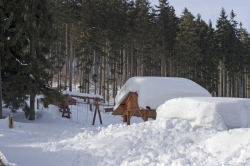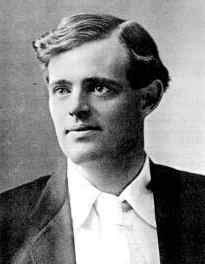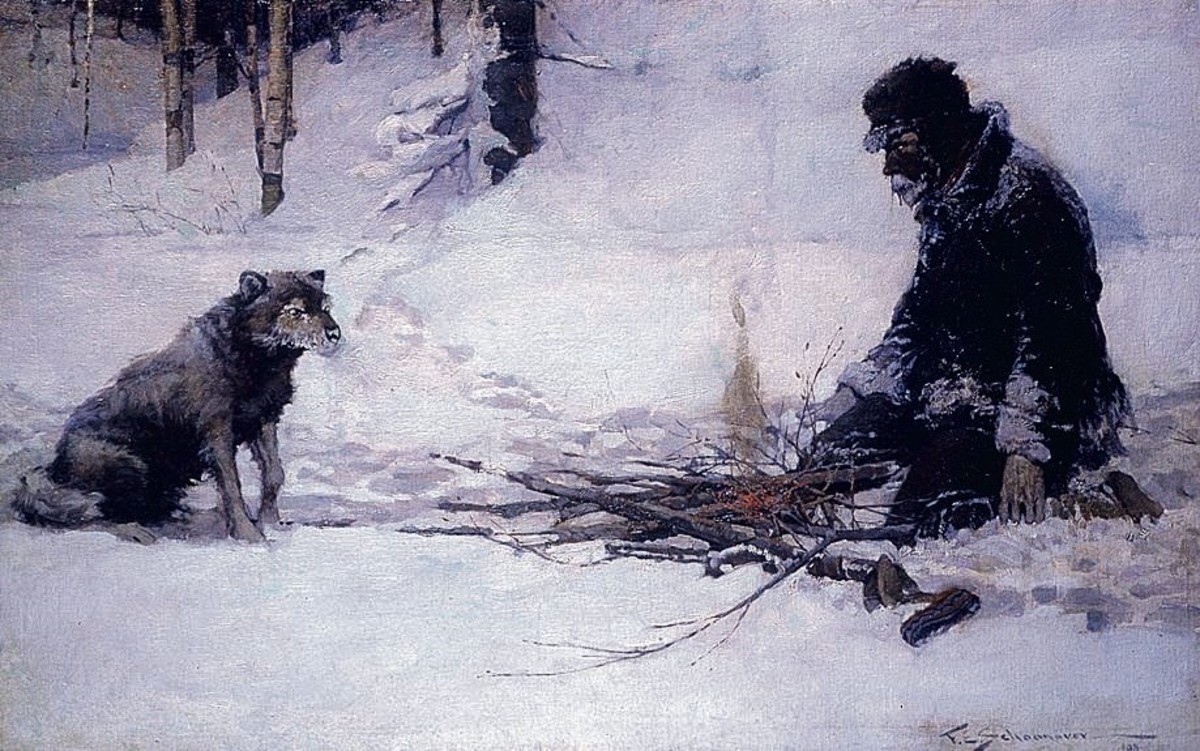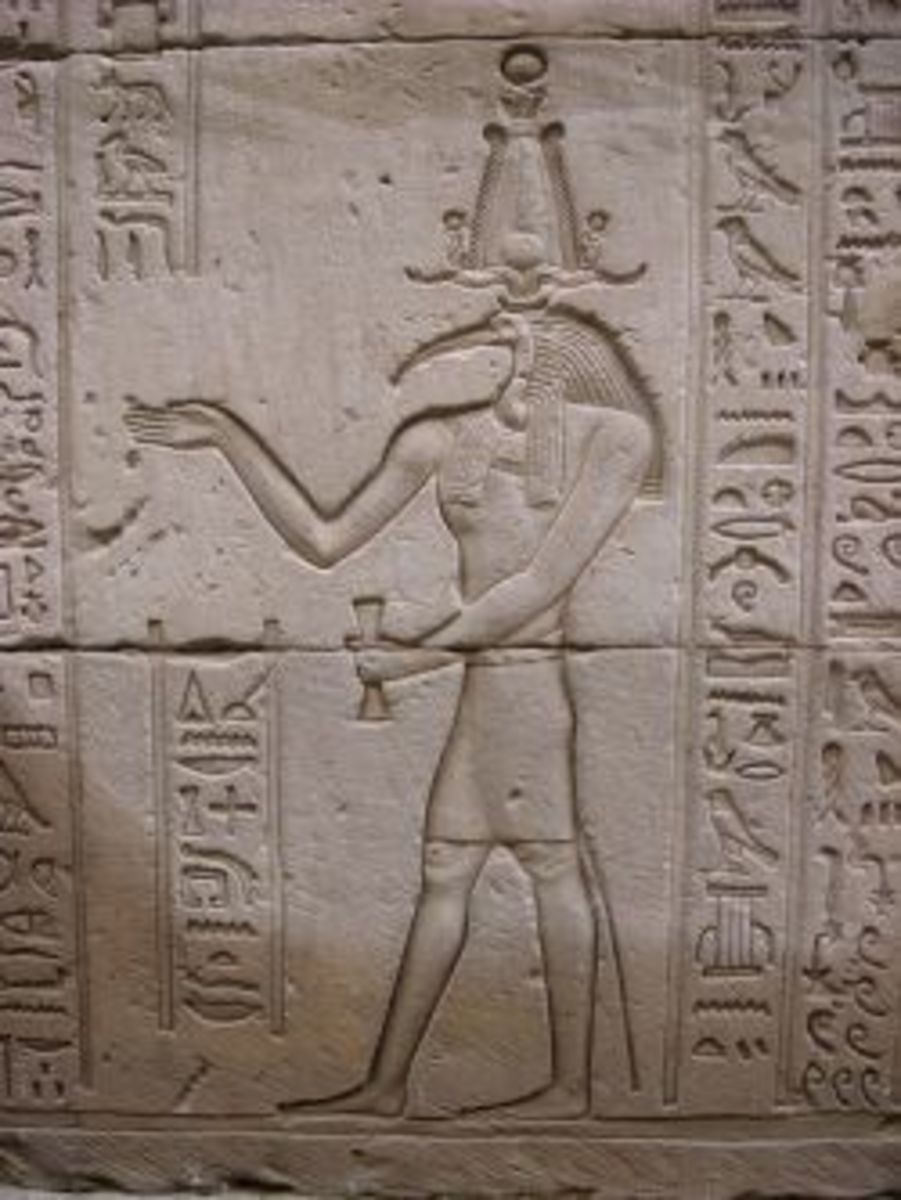To Build a Fire and The Scarlet Ibis - comparison

To Build a Fire
The sentence structure of To Build a Fire of Jack London is very simplistic, echoing the simplicity of the main character who does not understand the warning behind the image of the dark hairline, 'But all this--the mysterious, far-reaching hair-line trail, the absence of sun from the sky, the tremendous cold, and the strangeness and weirdness of it all--made no impression on the man.' The rhythm of the story is not poetic like in The Scarlet Ibis of James Hurst , rather the sentences sound like pure prose.
The man has no poetic inclinations in him and it is perhaps this lack of keen instinct that brings about his downfall.
To Build a Fire recounts the brutal simplicity of nature in terse matter of fact language . In this way we understand that nature is king. Take the matter-of-factness of this sentence: 'Fifty degrees below zero meant eighty-odd degrees of frost.' Nouns are recounted in terse simplicity, 'that must be guarded against by the use of mittens, ear-flaps, warm moccasins, and thick socks.'
The use of simple vocabulary in To Build a Fire further builds on the theme of the simplicity of man and nature. Take these adjectives 'cold and gray' and 'dim', and 'fat'. They are simple objective descriptions that are not warm and evocative like ones in A Scarlet Ibis, which uses more personal, descriptive and nostalgic language 'summer has since fled and time has had its way'.
To Build a Fire's objectivity is very powerful and allows us to observe the man with a growing feeling of doom for his situation.
As Michele L. Kreidler describes 'The singular motif in "To Build A Fire" is survival. This motif is expressed through the imagery of cold, especially as portrayed in the man's experience of frostbite, freezing extremities, and the freezing amber tobacco juice ice clinging to his beard.'(1)
Survival is about brute strength and the feature of numbers used throughout the story denotes a realism that begins with the sentences in the introduction, 'that led south five hundred miles to the Chilcoot Pass, Dyea, and salt water; and that led north seventy miles to Dawson, and still on to the north a thousand miles to Nulato, and finally to St. Michael on Bering Sea, a thousand miles and half a thousand more'. These numbers later become sinister in their symbolism - it is the seventy matches that refuse to light for the man and provide the warmth of the fire. Magill commented, 'London was not one to gloss over unpleasantness, and in "To Build a Fire" he described just how harsh the world can be to someone who disregards its laws.'(2)
Updated: Wednesday 20 August 2014
The Scarlet Ibis

Comparison of To Build a Fire and The Scarlet Ibis
The flatness of London's prose echoes this theme of naturalism, 'And perhaps the greatest embarrassment has been caused by Jack London, whose flat prose seems especially open to criticism. Indeed the very strangeness of naturalism's vision emerges so vividly in its prose that wrenched stylistic maneuvers soon seem to the point.'(3)
In the Scarlet Ibis the main motif is Doodle's inability to survive yet the simplicity of the crippled boy is not foreshadowed by the introduction to the story. Rather we are told in an overly complicated sentence that is supposed to convey his death that, 'A grindstone stands where the bleeding tree stood, just outside the kitchen door, and now if an oriole sings in the elm, its song seems to die up in the leaves, a silvery dust.' This is not the language used to convey the death of a young boy.
The repetition of 'cold and grey' in To Build a Fire is more effective in introducing the setting, as is the alliteration used in 'cold and uncomfortable'. Adjectives used like 'cheerful orb' is onomatopoeic depicting the cold and the 'mysterious far reaching hair line trail' is a very simple description showing again the simplicity of the theme of the tale. There are no fragments and all the sentence structures are easy to understand.
In The Scarlet Ibis the overly complicated sentence 'their smell drifted across the cotton field and through every room of our house, speaking softly the names of our dead' contains alliteration of 'smell speaking softly' to describe the quiet hush of the dead. The adjectives are elaborate and exotic like 'silvery dust' and the 'bleeding tree' which seems inappropriate for describing the harsh simplicity of nature. The figure of speech 'it's strange hat' invites the reader into the storyline personally as does the tone of the narrator.
Nevertheless the narration in To Build a Fire is more immediate and therefore more effective in recounting a tale that depicts the sudden and unfortunate death of the protagonist.
Works Cited
Jack London's "To Build a Fire" Kreidler, Michele L.. Literary Contexts in Short Stories: Jack London's "To Build a Fire", Understanding Literature -- Literary Contexts in Poetry & Short Stories, 2009, p1-1, 1p.
To Build a Fire Essay by: James Feast. Magill's Survey of American Literature, Revised Edition, 2007. (Work Analysis)
'Keeping His Head': Repetition and Responsibility in London's 'To Build a Fire'. Mitchell, Lee Clark. Journal of Modern Literature, Mar86, Vol. 13 Issue 1, p76, 21p.
Beautiful thought of Susie Lehto about To Build a Fire
SquidAngel and Lensmaster Tipi.
To Build a Fire by Jack London is a stark and raw account of the realities of survival in the harshest of conditions and the simplicity points to just that....its one foot in front of the other and you hope you have that next step in you....many didn't and many have survived while all they loved didn't. Reality is sobering....and simple...

Which Short Story do you Prefer?
Do you Prefer The Scarlet Ibis or To Build a Fire?
Read these books about To Build a Fire (or listen to)
- To build a fire
Book and audiobook. - To build a fire
Free Book - To build a fire
Free Book - The Scarlet Ibis
audio adaptation










